Smith's St. Leonard Chafing Dish
July 2009
By Alex Glass, MAC Lab Public Archaeology Asst.
In 1999, during a project to stabilize shoreline erosion at Jefferson Patterson Park and Museum, an archaeologist monitoring the construction noticed artifacts being pushed to the surface after large trucks
drove along the edge of the Smith's St. Leonard archaeological site. Smith's St. Leonard is the location of an early to mid-eighteenth century tobacco plantation, owned by Richard Smith, Jr. and his
sons.
In 2002, archaeologists began to excavate the area where the artifacts had appeared on the surface. They uncovered a trash pit that the inhabitants of the Smith's St. Leonard site may have filled near
the end of the site's occupation around 1754 (Grow 2006: 37). Many interesting artifacts were recovered from this excavation, including the base of a copper alloy chafing dish. Described by Randall Holmes
in 1688, a chafing dish "is a kind of round pan, set on feet, with a handle to move it from place to place; it’s office is to hold hot coales of fire in, and to set dish meates theron, to keep them
warm, til the time of serving up to the table, or to heate a cold dish of meate on the table" (cited in Fennimore 1996:100). While some chafing dishes were made of ceramic, a majority were manufactured
from metals such as copper, iron, or brass (Fennimore 1996: 100, Pearce 1992: 21).
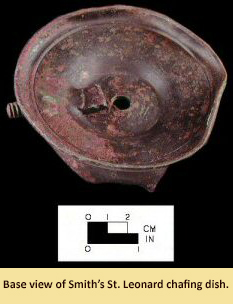
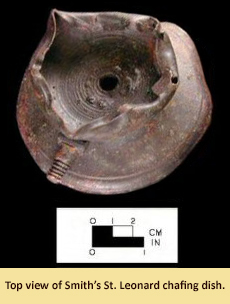
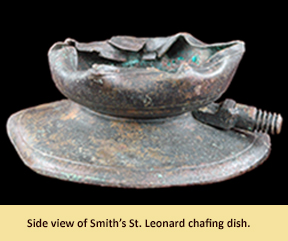
A chafing dish like the one found at Smith’s St. Leonard could have been used by the Smiths to reheat a food dish as it cooled, since the kitchen was kept separate from the main house and dining area.
Until the early 1800s it was more common to use chafing dishes that required the use of hot coals to keep food warm (Fennimore 1996:101). The dish found in the trash pit, however, used a different
technology. Composed of three pieces, this copper alloy chafing dish would have had a top plate which unscrewed from the base and enclosed an iron ring (Fennimore 1996:100). The iron ring would
be placed in a fire until it was hot, and then set between the top plate and the base of the dish (Fennimore 1996:100). The entire dish was made movable by an attached wooden handle located on the
side of the base. Unlike the coal and ember-holding chafing dishes, the chafing dish found at Smith's St. Leonard would have eliminated the unpleasant smoke and smell of burning wood (Fennimore 1996:101).
The Smith's St. Leonard chafing dish is nearly identical to one in the collections at Winterthur, which was probably produced in Germany between 1710 and 1760, although it could also have been
made in either Sweden or the Netherlands (Fennimore 1996:101). Based on other artifacts found with the Smith's St. Leonard chafing dish, it appears that it was discarded around the 1750s. Although the
excavated chafing dish would have had three parts, the top plate and iron heating ring have not yet been found. The wooden handle is also missing, and most likely decomposed. It is possible that
the chafing dish was discarded due to its broken or missing components.
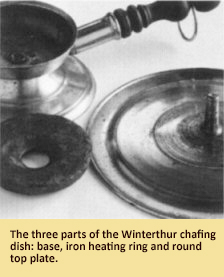 |
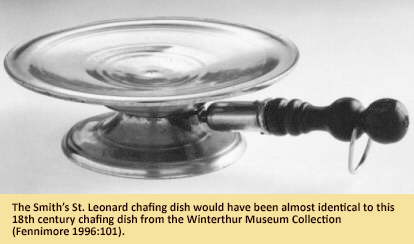 |
| References |
|
| Fennimore, Donald L. |
| 1996 |
Metalwork in Early America: Copper and its Alloys. Winterthur Publications, Winterthur, Delaware. |
|
| Grow, Jessica L. |
| 2006 |
Excavations at the Smith’s St. Leonard Site (18CV91). Report prepared for Jefferson Patterson Park & Museum St. Leonard, MD and University of Maryland Masters of Applied Anthropology Internship. |
|
| Pearce, Jacqueline |
| 1992 |
Border Wares: Post-Medieval Pottery in London, 1500-1700. HMSO Publications, London. |
|